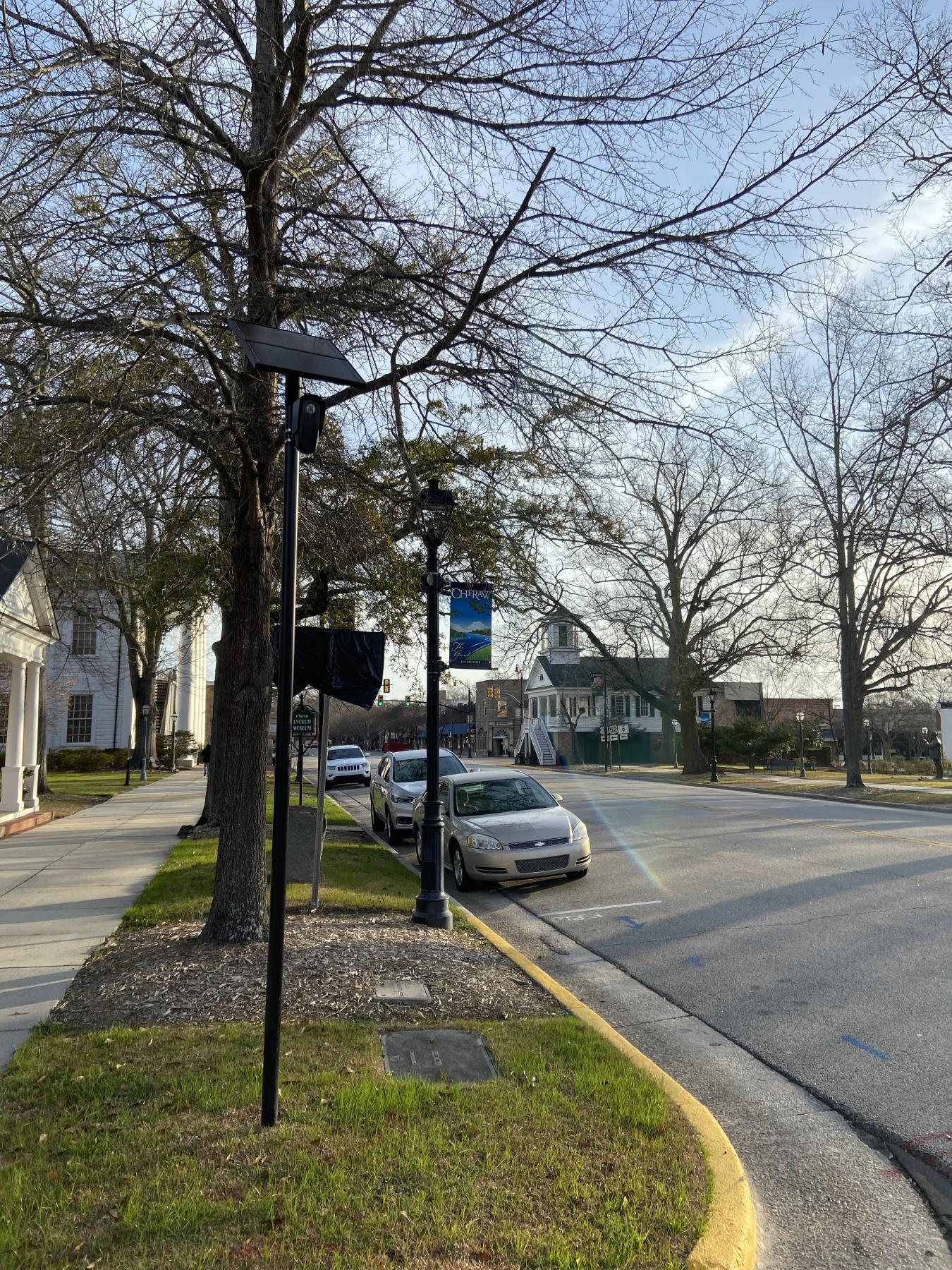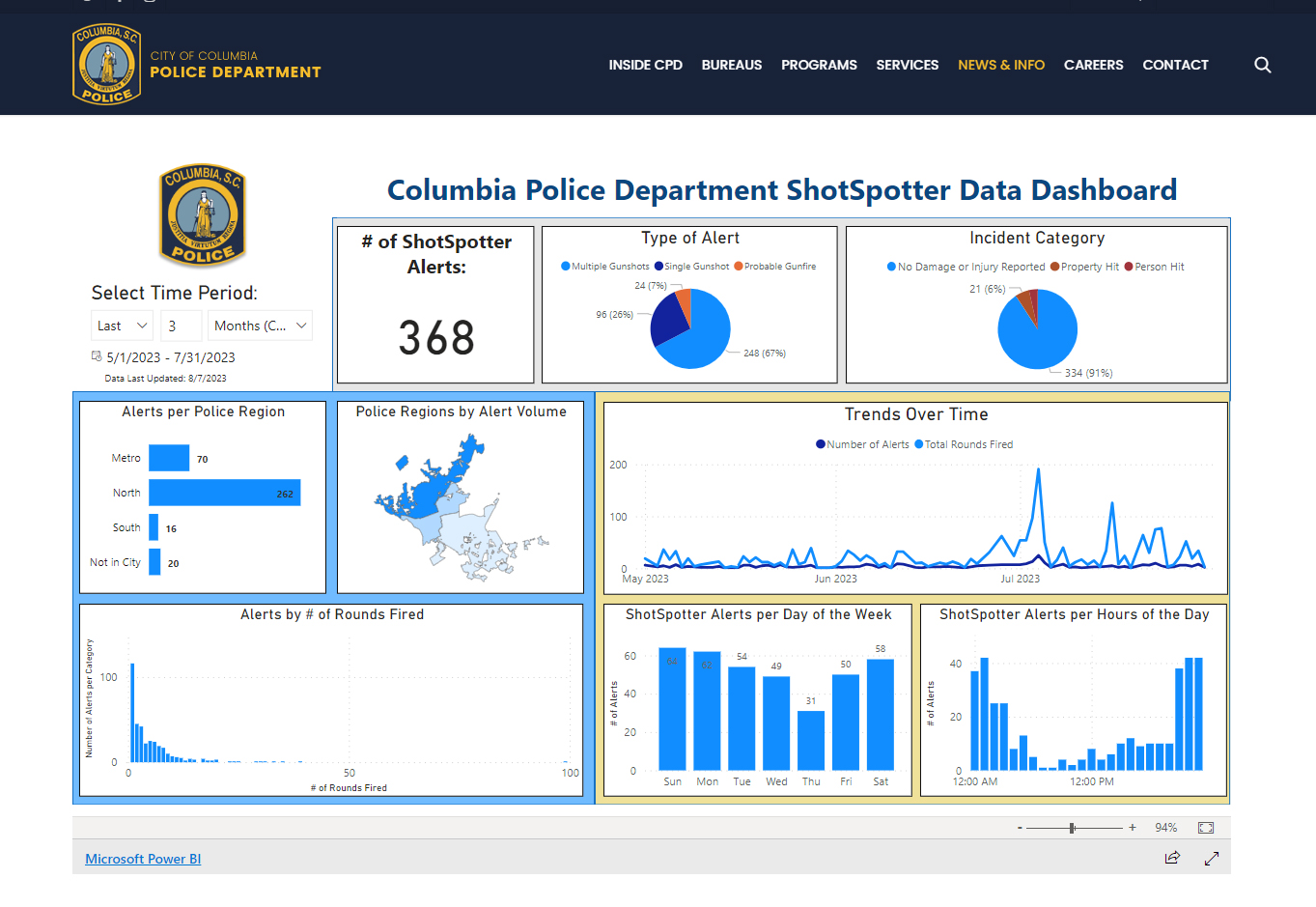
From cameras that capture pictures of license plates to technology that can pinpoint where gunshots are fired, advancements in technology are part of law enforcement in every corner of South Carolina.
While law enforcement has historically relied on mutual aid agreements with other cities and counties as a way to amplify a police department’s effectiveness, technology is now offering a new opportunity to expand a department’s reach.
“Technology has emerged in the last 10 years as a force multiplier for law enforcement,” said City of Columbia Police Chief W.H. “Skip” Holbrook. “It comes with an expense, but it’s been a reliable force multiplier.”
In Cheraw, for example, the town grappled with ways to deal with increasing property crimes in a rural area with limited resources. The solution? Solar-operated cameras are strategically placed at intersections in town to capture the license plate of every car that passes through.
Officers can get a sense of what vehicles were in the area when a crime occurred, narrowing down possible suspects. The information from the cameras also goes to the National Crime Information Center database, which checks license plates against any known active warrants, missing persons or other issues.
Any time someone has a warrant or a car is stolen, the cameras send a “ping” to all of the patrol officers with a time, description and location. In the two years since the program began, the cameras have helped the town recover multiple stolen vehicles and license plates, find three missing persons and assist in at least one homicide investigation, said Rob Wolfe, Cheraw’s town manager.
He also described the system as a police “force multiplier” — one “that allows us to better track and catch criminals.”
Originally, several of these cameras were installed in a neighborhood as part of a Community Development Block Grant Neighborhood Revitalization Program. Because they had a noticeable impact on crime rates, Cheraw expanded the program to cover the entire town.
“In this scenario, these cameras are the equivalent of having a police officer stationed at every strategic intersection in town, and that officer [being able] to run every license plate that goes past them,” Wolfe said.
Even in a small town like Cheraw, the most active street in town has about 18,000 vehicles go by daily.
“As you can imagine, rural communities across the country are struggling with recruitment of police officers, costs are skyrocketing beyond the ability of tax revenue to keep up, and in many places, the population is shrinking,” he said. “All of this combined means that we have to be strategic in how we utilize limited financial resources.”
The cost of Cheraw’s 48 cameras is about $2,500 per camera per year, with the money coming from city’s general fund. The system’s total cost is about the same as funding 1.5 police officers, when factoring in salary and benefits.
“I believe the important takeaway from our camera system is that it demonstrates the power of adapting technology to city services, and that any municipality should be willing to experiment with new technologies to increase effectiveness of services — be it public safety, utilities, public works, planning or finance,” Wolfe said. “Smart cities are coming, and I am a firm believer that cities must adapt to changing times and circumstances. I see our camera system as a prime example of how we can overcome challenges in our rural community by adopting new technologies.”
In Columbia, the police department had a robust camera surveillance system paired with analytic capabilities when it started looking deeper at some of the capital city’s emerging threats, particularly violent crime, said Chief Holbrook.
“We determined that [violent crime] is geographic-centric here, and very offender-specific. We thought that we can work on the offenders, but we really need to think differently in knowing where it’s occurring,” he said. “What technology can we leverage to help us?”
The department looked into various tools, studied other cities and decided in 2019 to implement ShotSpotter, a gunshot detection technology that uses acoustic sensors to pinpoint where gunfire occurs. The system triangulates the sound of gunfire and within 45 seconds gives that information directly to police officers to respond.
When the city looked at where it wanted to deploy the technology, Holbrook stressed that the decision had to be data-driven. The city first used ShotSpotter in 6 square miles of what the city considers to be locations with elevated risk of gunfire and people hit by gunfire. It has since added an additional square mile.
“This is a really important part of this — you also have the trust and legitimacy part of policing. The areas we felt would benefit the most from ShotSpotter just happened to be the areas where there is the greatest lack of trust in law enforcement,”
he said.
As Columbia was preparing to implement the system, ShotSpotter representatives told the police department that 75 to 80% of gunfire typically goes unreported.
“I thought to myself, ‘That is absolutely impossible.’ Because I knew how many calls for service we had to gunfire and to people being hit,” he said. “Fast forward to when we flipped the switch and turned the system on, we saw exactly what they said we would see.”
Once ShotSpotter alerted officers to gunfire, the department would wait for a corresponding citizen to report gunshots in their neighborhood.
“And we would not get that call. It was about 75 to 80% of calls we were self-initiating based on the technology. I was like, ‘Wow. Why are we not getting calls? Is it they don’t trust us? That they think we don’t care? Do they think somebody else is calling? Do they just chalk it up as part of where they live?’ All the answers to those questions are bad answers in my opinion,” Holbrook said.

The department set a protocol to go to 100% of the ShotSpotter alerts, where they would find shell casings and other evidence showing that it was not a false alert. Officers would canvass the area and put out door hangers telling residents there had been a shooting reported in the area and asking for help.
The attention worked. Now, most ShotSpotter alerts are accompanied by a call for service from citizens, he said. And along with community input, the commitment to ShotSpotter has also resulted in more grant funding for the city.
“It also has opened additional doors for acquiring technology and being competitive for grant technology for innovative policing tactics,” he said.
Holbrook said Columbia has taken all of its technology, bundled it and set up a real-time crime center in the city’s emergency operations center.
“It looks like something you’d see at NASA. It’s a whole wall of video, that has the map of the city, shows where our officers are, shows where calls for service are, shows shots fired, shows cameras and license plate readers,” he said. “Officers sit there and monitor that. They quarterback what’s going on in the city in real time.”
“We are using people, canines, cameras, gunshot technology and all the analytics that come with it,” he said. “All of that is part of our initiative to reduce violent crime in Columbia.”
Cheraw’s camera system won the town a 2023 Municipal Association Achievement Award. See a video explaining the project at www.masc.sc.
